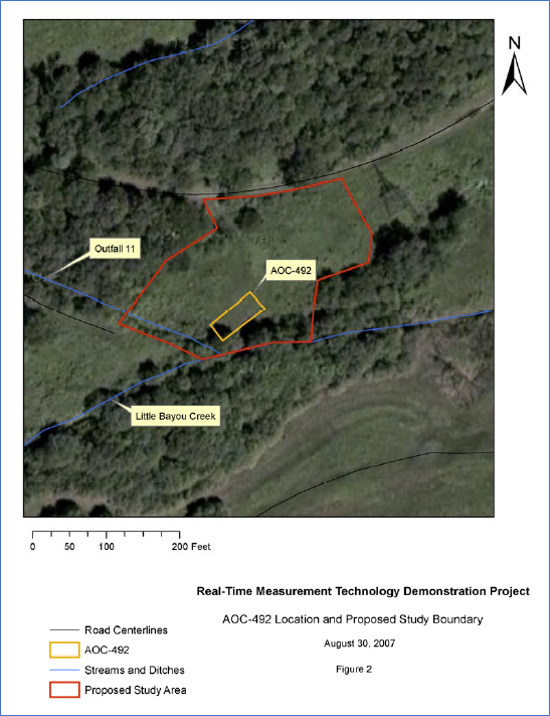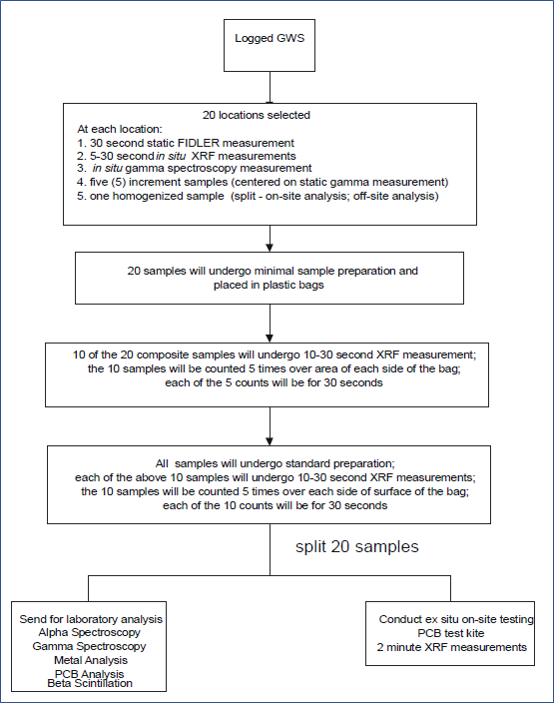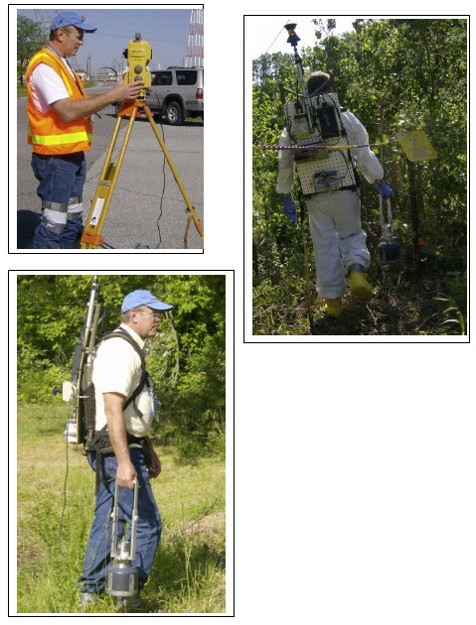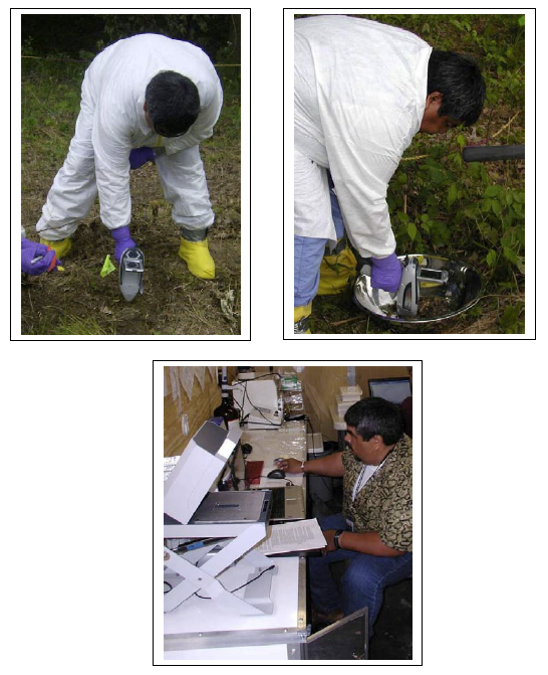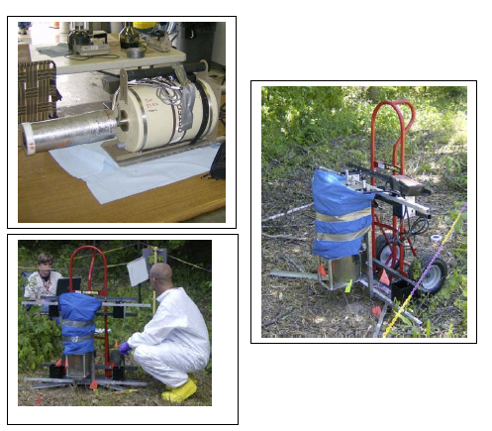GeoSciences Soil & Sediment
Characterization & Remediation
“REAL-TIME” SOIL CHARACTERIZATION AND REMEDIATION DEMONSTRATION PROJECT
Argonne National Laboratory, UK, industry and PGDP scientists developed and demonstrated a tailored, site-specific approach to utilize state-of-the-art field instrumentation to conduct a PGDP soil/sediment project from characterization through remediation and verification of cleanup. The “Real Time” Demonstration Project (RTD) accomplished characterization and cleanup of PCB, metal, and radionuclide contamination on the 16-acre AOC-492 site (Figure 1) in a 3-week field mobilization versus the typical 3-4 years necessary for completing existing iterative field project life cycles.
The project integrated key conceptual approaches from Argonne National Laboratory, the Adaptive Sampling and Analysis Plan (ASAP) approach, and the U.S. Environmental Protection Agency (EPA) TRIAD approach. Following project completion TRIAD and ASAP training was provided to PGDP DOE staff, PGDP contractor staff, university staff, EPA staff, Kentucky regulators and the public.
Preliminary RTD project efforts included rigorous testing to verify performance and project suitability for X-ray Fluorescence (XRF) metal quantification field instruments and PCB field test kits. XRF performance verification was conducted with the assistance of private industry and PCB field test kit performance verification was conducted cooperatively with USEPA’s Technology Innovation Field Services Division (Las Vegas).
The RTD Project technology suite (Figure 2) included: 1) logged gamma walkover surveys (GWS) for gamma-emitting radionuclides; 2) discrete in-situ gamma measurements (Figures 3-6); 3) in-situ high purity germanium (HPGe) gamma spectroscopy for radionuclides; 4) in-situ and ex-situ XRF for metals including total uranium; and 5) field test kits for polychlorinated biphenyls (PCBs). Multi-increment sampling and adaptive compositing techniques were included in the dynamic work strategy applied to the study area. In addition to in-situ and ex-situ measurements accomplished in the field, composite samples were analyzed by fixed laboratory to support the real-time technologies.
The Real Time Technology Application Demonstration Project final report and project concept presentations discuss the project approach and the application of field and laboratory methods.
Project Team
Dr. Robert Johnson, Applied Environmental Science, Argonne National Library (Co-PI)
Dr. John Volpe, KRCEE (Co-PI)
Dr. Richard Bonczek, Technical Project Manager & Risk Assessor, Portsmouth-Paducah Project Office, U.S. Department of Energy
Jon Richards, Health Physicist, Region 4, U.S. Environmental Protection Agency
Steve Meiners, Radiation Safety and Industrial Health and Safety, Tricord, Inc.
Deana Crumbling, Technology Innovation and Field Services Division, U.S. Environmental Protection Agency
Mike Dillon, Eberline Services
Dave Lawrence, Eberline Services
Dave Lasher, Eberline Services
Larry Payne, Tricord, Inc.
Jason Boulton, Geo Consultants
Windy Gregory, Tricord, Inc.
Hipolito Hernandez, Eberline Services
Chris Higgins, Eberline Services
Jim Craig, Eberline Services
Frazer Johnstone, Paducah Remediation Services
James Kipp, Associate Director, KWRRI
Stephanie Jenkins, KRCEE
Steve Hampson, Associate Director, KRCEE
Project Documents
| Project Concept Presentation | Johnson, R.L., Case Study: ASAP Techniques in Support of Precision Excavation |
| Project Concept Presentation | Johnson, R.L., PGDP Case Study Improving Volume w Dynamic Work Strategies |
| Project Concept Presentation | Johnson, R.L., Strategies and Tools for Improved Management of Uncertainties at Contaminated Sites |
| Project Concept Presentation | Johnson, R.L., An Introduction to the Triad Approach |
| Project Final Report | Volpe, J.A., Johnson, R.L. & Hampson, S., Real Time Technology Application Demonstration Project Final Report, KRCEE Doc# P18.32, 2008 |
| Project Supporting Study Document | Crumbling, D., USEPA TIFSD Soil PCB Pilot Study Experimental Design Plan, 2008 |
| Project Supporting Study Report | Johnson, R.L., Real Time Demonstration Project XRF Performance Evaluation Report for Paducah Gaseous Diffusion Plant AOC 492 , April 2008. |
| USEPA Newsletter | Bonczek, R., Johnson, R.L., Hampson, S., ‘Single Field Mobilization Completes Site Investigation and Removal Actions’, in USEPA Technology News and Trends, Issue 40, January 2009, pp. 3-4. |
| USEPA Quick Reference Fact Sheet | Bonczek, R., Johnson, R.L., Hampson, S., “Profile: Paducah Gaseous Diffusion Plant, Paducah, KY,” in Green Remediation: Best Management Practices for Excavation and Surface Restoration. United States Environmental Protection Agency Office of Solid Waste and Emergency Response, EPA 542-F-08-012, December 2008. |
| Project Supporting Document | Argonne National Laboratory, Field Sampling Plan for AOC 492, Real Time Measurement Demonstration Project, KRCEE 18.11 2008d, December 2007. |
| Supporting Professional Presentation | Richards, J. (USEPA Region IV), Real-Time Demonstration Project: Dynamic, Real-Time Characterization, Remediation, and Verification of Cleanup for PCBs and Radionuclides in Soil/Sediment at the Paducah Gaseous Diffusion Plant, Paducah, Kentucky, USEPA Radiation Superfund Meeting, April 2008. (not linked) |
| Supporting Professional Presentation | Volpe, J.A., Real-Time Demonstration Project: Dynamic, Real-Time Characterization, Remediation, and Verification of Cleanup for PCBs and Radionuclides in Soil/Sediment at the Paducah Gaseous Diffusion Plant, Paducah, Kentucky, Conference of Radiation Control Program Directors Annual Meeting, Columbus, Ohio, February 2009. (not linked) |
| Supporting Professional Presentation | Johnson, R.A., Real-Time Demonstration Project: Dynamic, Real-Time Characterization, Remediation, and Verification of Cleanup for PCBs and Radionuclides in Soil/Sediment at the Paducah Gaseous Diffusion Plant, Paducah, Kentucky, Interstate Technology and Regulatory Council (ITRC) National Meeting: Presentation and Discussion, Louisville, Kentucky, December 2009. (not linked) |
| Supporting Presentation | Hampson, S., Real Time Remedial Demonstration Project Introduction, PGDP Citizens Advisory Board (CAB) Presentation, Paducah, Kentucky, May 2006. |
| Supporting Presentation | Hampson, S., Real Time Demonstration Project Introduction, PGDP Site Managers Meeting Presentation, Kevil, Kentucky, May 2006. (above) |
| Supporting Presentation | Hampson, S., Real Time Demonstration Project Introduction, KRCEE Quarterly Meeting Presentation, Lexington, Kentucky, May 2006. (above) |
DESIGN OF COST-EFFECTIVE, REAL-TIME IMPLEMENTABLE,
SEDIMENT AND CONTAMINANT RELEASE CONTROLS
UK Biosystems and Agricultural Engineering Department and KWRRI developed alternative, readily implementable, design options for integrated storm water and sediment control systems for PGDP Outfalls 008, 011 and 015.
The project’s remedial options design process utilized the SEDCAD surface water and sediment release model with historical PGDP watershed flow and sediment concentrations. Outfall watershed discharge and sediment loading were modeled.
Remedial options were required to meet performance objectives, be cost effective, readily implementable, and require minimal excavation disturbance for placement.
Project remedial options and recommendations for future watershed monitoring are provided in the project final report.
Project Team
Dr. Richard Warner, Professor, Biosystems and Agricultural Engineering, University of Kentucky (PI)
Dr. Lindell Ormsbee, Director, KWRRI, and Professor, Civil Engineering, University of Kentucky (Co-PI)
Dr. John Volpe, KRCEE
Steve Hampson, Associate Director, KRCEE
Project Documents
SURFACE WATER TOTAL MAXIMUM DAILY LOAD (TMDL) DEVELOPMENT
The Kentucky Water Resources Research Institute (KWRRI), Murray State University, and UK Civil Engineering conducted an extensive hydrologic and water quality evaluation of the PGDP and associated watersheds.
TMDL Development Project Phase 1 compiled and assessed available surface water flow and water quality data to develop TMDL criteria for surface water associated with the PGDP.
Based on TMDL Phase 1 data assessment it was determined that additional field data were needed to complete evaluation and recommendations for Cu, Fe, Pb, and Hg in Bayou and Little Bayou Creeks. During 2009 the TMDL Phase 2 Project collected supplemental metal-of-interest data from Bayou Creek, Little Bayou Creek, and reference locations.
The project final report discusses the evaluation of supplemental data and provides TMDL recommendations.
Project Team
Dr. Lindell Ormsbee, Director, KWRRI, and Professor, Civil Engineering, University of Kentucky (Co-PI)
Dr. Chandramouli Viswanathan, KWRRI
Andy Kellie, Professor (Emeritus), Industrial Engineering and Technology, Murray State University
Dr. Michael Kemp, Professor, Industrial Engineering and Technology, Murray State University
Jane Benson, Mid-America Remote Sensing Center, Murray State University
Michael Matthews, Industrial Engineering and Technology, Murray State University
Matthew Phillip, Industrial Engineering and Technology, Murray State University
Ben Albritton, KWRRI
Clay Johnson, KWRRI
Steve Meiners, Tricord, Inc.
Project Documents

